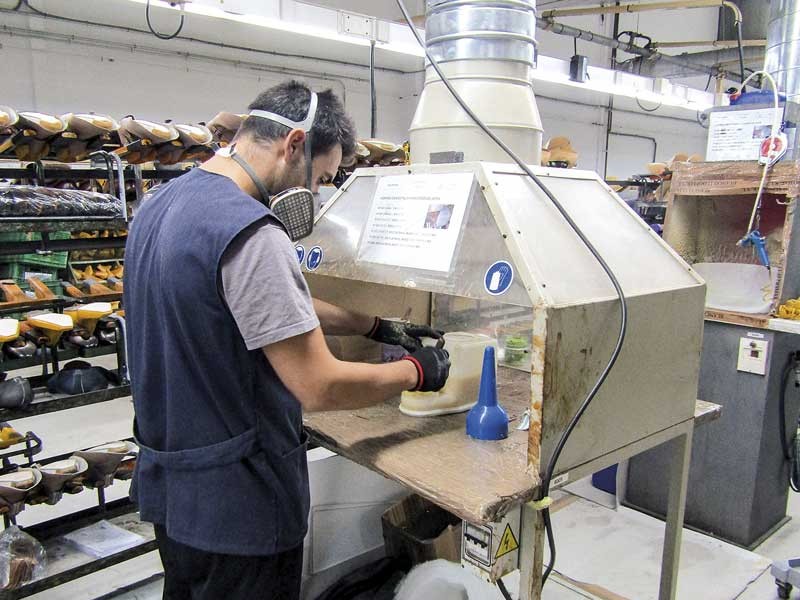


The manufacture of footwear is an assembly process of several components, made up of various materials, where the different adhesives play a fundamental role, since without them the shoe would lack shape and structure.
In this sense, to understand the importance of adhesives in the footwear industry, it is first necessary to identify the substrates and processes where adhesives are involved, as well as their technical requirements. The performance of the glue depends on the nature of the different adherents used as footwear materials, the design of the joints, the surface treatments, the adhesive properties that depend on its formulation, etc.
Adhesive bonds in footwear act under different types of stress (gluing, shearing, traction, etc.). The most unfavorable is the stress of gluing, for this reason, the test of its resistance is one of the most used to evaluate the performance of the final gluing.


The union of the upper part to the sole is the most demanding process in the manufacture of footwear since it demands a high cohesive force. The upper includes the instep that covers the front part, the toe cap, the waist and the heel seat. The base is the lower part of the shoe, made up of the insole, the midsole, and the sole.
The adhesion between shoe upper and sole can be improved by modifying the surface of the sole and/or upper materials, and by changing the adhesive formulation, or both. Depending on the type of footwear, different bonding performance is required.
Although, on the one hand, sports or safety shoes are extremely demanding in terms of adhesion strength, due to the more rigorous conditions in which they are used; on the other hand, the requirements for fashion or casual footwear are not as stringent. In this sense, the correct choice of adhesive is essential to ensure the cohesive force required by both shoe manufacturers and regulations. Currently, contact adhesives based on polychloroprene -PCP- and polyurethane -PU- are the most widely used in the footwear industry.
As superior materials, chrome and vegetable tanned leather is the most used in the manufacture of footwear. The porous nature of leather facilitates adhesive bonding, but its weak grain layer must be removed by roughing and scraping.
For good adherence to oily leather, it is recommended to apply a primer. On synthetic materials, such as canvas, textiles, nylon, etc., a preliminary scraping and/or solvent cleaning is performed, followed by the application of two consecutive coats of adhesive, to achieve a secure bond.
Soles can be made of leather, natural polymers (crepe rubber) or synthetic, cork, etc. Synthetic polymeric materials used to manufacture shoe soles are based on polyurethane (PU), thermoplastic polyurethane (TPU), thermoplastic rubber (TR), styrene-butadiene rubber (SBR), styrene-butadiene-styrene rubber (SBS), ethylene-vinyl acetate (EVA), polyamide (PA), polyvinyl chloride (PVC), polystyrene (PS) or acrylonitrile-butadiene-styrene (ABS). PS and ABS materials are mainly used for heels.
The selection of materials will depend on their mechanical properties, price and adequacy to the design, thus determining the resistance, quality and comfort desired for the final product.

In the footwear industry, polychloroprene (PCP) adhesives show good results with leather, textiles and other materials, such as vulcanized rubbers. However, the appearance of new fashions and plastic materials in the 1970s, which contained large amounts of plasticizers, made it necessary to search for alternative adhesives. For this reason, polyurethane (PU) adhesives were introduced, which are currently the most widely used for gluing soles due to their great versatility and performance.
Polychloroprene and PU adhesives are mainly used for very demanding bonding, such as upper-sole. Other synthetic and natural polymer-based adhesives such as styrene-isoprene-styrene (SIS), styrene-butadiene-styrene (SBS), styrene-butadiene rubber latex (SBR), hot-melts (polyamide-based, EVA), etc., are used in different manufacturing operations. The selection of the adhesive is made based on the technical requirements of each operation.
In the case of PU adhesives, after being applied and dried, they must be activated with heat (adhesive softening), so that they acquire tack that allows the union of both adhesive layers. The substrates are then bonded by pressing the materials and the adhesive bond cools in seconds, although it takes 24 hours for final curing. When an isocyanate-based crosslinker is added to a PU adhesive (2K two-component adhesive) the curing process is irreversible, which means that the adhesive is permanently crosslinked and the durability of the adhesion is greatly increased.
